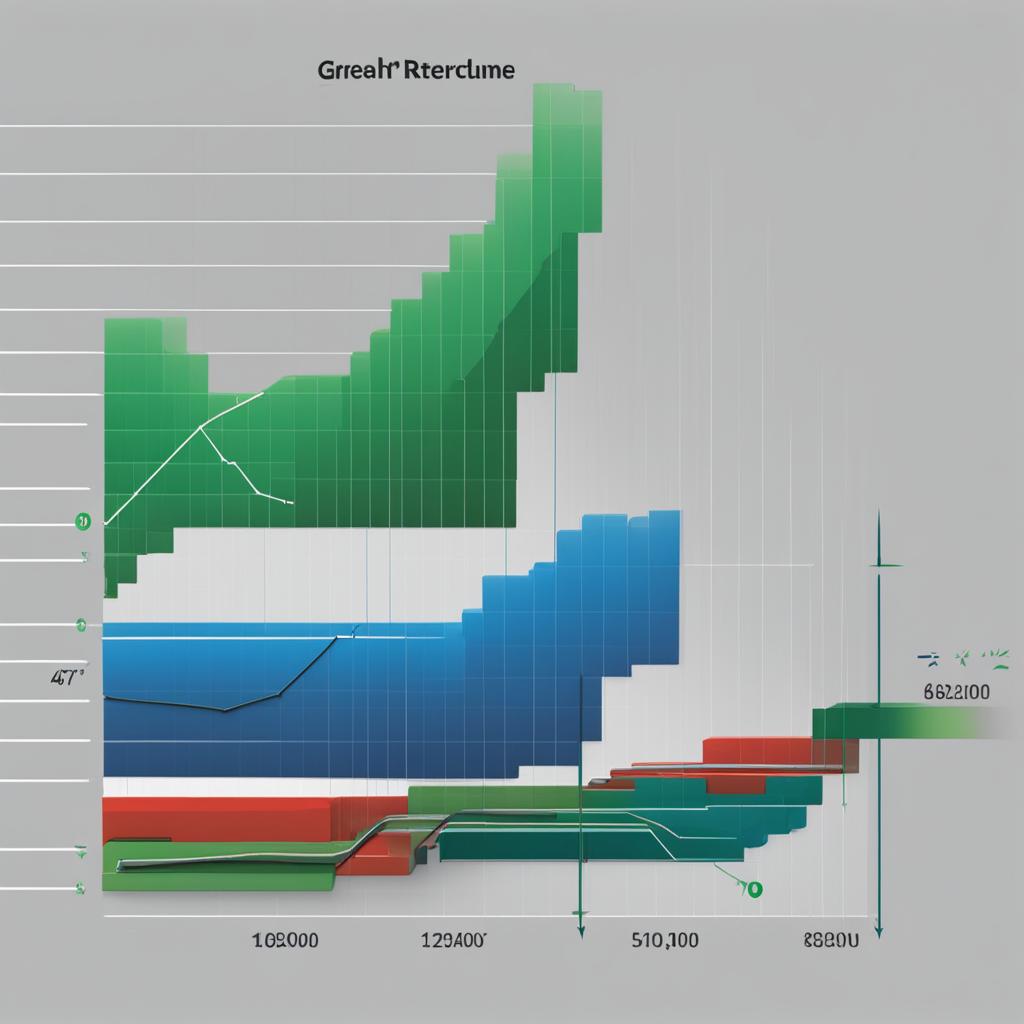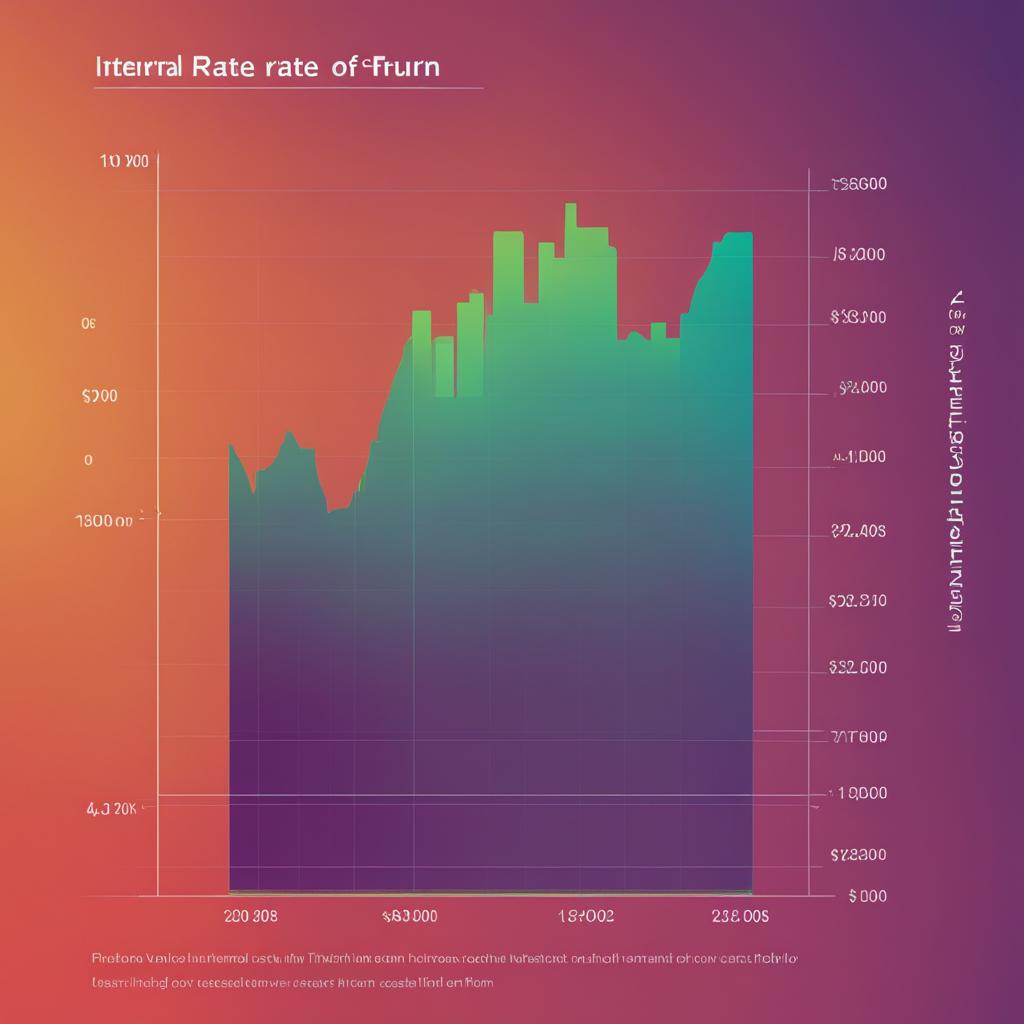Gaining a thorough understanding of the rate of return (RoR) is essential for any investor. Whether you’re new to investing or a seasoned pro, knowing how to calculate and interpret the rate of return can help you make better investment decisions and maximize your returns. In this article, I will explain what the rate of return is, how it is calculated, and why it is crucial in evaluating the performance of your investments.
Key Takeaways:
- The rate of return (RoR) measures the net gain or loss of an investment over a specified time period.
- It is calculated by comparing the initial cost of the investment to the current value and expressing the change as a percentage.
- The rate of return can be applied to various assets such as stocks, bonds, real estate, and art.
- Consider both the simple rate of return and the real rate of return, which factors in inflation and the time value of money.
- Aim for a good return on investment by targeting an average rate of return that aligns with your financial goals and risk tolerance.
What Is a Rate of Return (RoR)?
A rate of return (RoR) is a vital metric that measures the net gain or loss of an investment over a specified time period. It is expressed as a percentage of the investment’s initial cost, allowing investors to evaluate the profitability and performance of their investments. The RoR calculation takes into account factors such as the initial cost, net gain or loss, and the duration of the investment.
The RoR concept applies to a wide range of assets, including stocks, bonds, real estate, and even art. Regardless of the asset class, the RoR formula remains consistent in calculating the percentage change from the investment’s start to end value. By assessing a range of investments, investors can determine the RoR of each and make informed decisions about their portfolio.
| Assets | Rate of Return (RoR) |
|---|---|
| Stocks | 6% |
| Bonds | 3% |
| Real Estate | 10% |
| Art | 8% |
It is important to note that the RoR calculation does not directly consider factors such as inflation or the time value of money. While it provides a simple and straightforward evaluation of an investment’s return, it may not capture the true purchasing power or long-term value of the investment. For a more comprehensive understanding, investors can also calculate the real rate of return, which accounts for inflation and the time value of money.
“The rate of return is a key metric in investment analysis, helping investors gauge the profitability and performance of their investments.”
One widely accepted benchmark for a good return on investment is an average annual return of around 7%. Interestingly, this is also the average annual return of the S&P 500, adjusted for inflation. However, it is essential to recognize that what constitutes a good return on investment can vary based on individual goals, risk tolerance, and market conditions.
By understanding the concept of the rate of return and how it is calculated, investors can make more informed decisions about their investments, optimize portfolio performance, and work towards achieving their financial goals.
Understanding a Rate of Return (RoR)
A rate of return (RoR) is a crucial metric that allows investors to evaluate the performance of various investment vehicles. RoR can be applied to a wide range of assets, including real estate, bonds, stocks, and fine art. Regardless of the investment type, the RoR is calculated based on the initial purchase price of the asset and the cash flow it generates over time.
Past rates of return play a significant role in investment decision-making. Investors often compare the historical performance of different assets within the same category to identify the most attractive investment choices. By analyzing past rates of return, investors can gain insights into an asset’s profitability and potential for future growth.
Before making an investment choice, many investors establish a required rate of return. This rate represents the minimum acceptable return on investment that investors aim to achieve. By setting this benchmark, investors ensure that their chosen investments offer the potential for sufficient profitability.
| Investment Vehicle | Past Rates of Return | Investment Choice |
|---|---|---|
| Real Estate | 8.5%, 6.2%, 11.1% | High returns shown. Potential investment. |
| Bonds | 2.4%, 3.1%, 2.9% | Lower returns indicated. May not meet required rate of return. |
| Stocks | 12.8%, 15.7%, 10.2% | Strong past returns. Attractive investment choice. |
| Fine Art | 4.6%, 7.3%, 5.1% | Solid returns observed. Worth considering as an investment. |
By understanding past rates of return, evaluating investment vehicles, and establishing a required rate of return, investors can make informed decisions to optimize their investment portfolios.

The Formula for RoR
Calculating the rate of return (RoR) is crucial for evaluating the performance of an investment. The formula to calculate the RoR is:
Rate of return = [(Current value – Initial value) / Initial value] x 100
The RoR formula determines the percentage change between the current value and the initial value of an investment. This simple rate of return is often referred to as the basic growth rate or return on investment (ROI).
In addition to the simple rate of return, other factors must be considered to gain a more accurate understanding of investment performance. One crucial factor is the time value of money. By adjusting for the time value of money, we can obtain the real rate of return, which takes inflation into account.
The real rate of return can be defined as the net amount of discounted cash flows (DCF) received from an investment after adjusting for inflation. This calculation provides a more accurate representation of the investment’s profitability over time.
By applying the RoR formula and considering the time value of money and inflation, investors can gain deeper insights into their investments and make informed decisions.
RoR on Stocks and Bonds
The rate of return calculations for stocks and bonds have slight variations. Let’s start with stocks.
Rate of return on Stocks
When calculating the rate of return for stocks, you need to determine the per-share gain, which is the difference between the sale price and the cost price, and then divide it by the cost price. For example, if I bought a stock for $60 per share, held it for five years, and received a total of $10 in dividends, I would calculate the rate of return as follows:
(Per-Share Gain / Cost Price) x 100%
($10 / $60) x 100% = 16.67%
So, the rate of return for this stock investment would be 16.67%.
Rate of return on Bonds
When it comes to bonds, the rate of return calculation takes into account the interest income and any gain from the sale of the bond. Let’s say I purchased a $1,000 par value bond with a 5% coupon rate, paid $1,000 for it, and later sold it for $1,100 with a total interest earned of $100. The rate of return would be calculated as follows:
(Total Gain / Cost Price) x 100%
($100 / $1,000) x 100% = 10%
So, the rate of return for this bond investment would be 10%.
These calculations show how rate of return calculations differ for stocks and bonds. It’s essential for investors to understand how to calculate the rate of return based on the specific characteristics of the asset in order to evaluate the performance of their investments effectively.
Real Rate of Return vs. Nominal Rate of Return
The simple rate of return is considered a nominal rate of return since it does not account for the effect of inflation over time. Inflation reduces the purchasing power of money, and so a certain amount of money in the future is not equivalent to the same amount of money today. Discounting is one way to account for the time value of money. Once the effect of inflation is taken into account, the rate of return is called the real rate of return or the inflation-adjusted rate of return.
When calculating the nominal rate of return, only the percentage change in the value of an investment is considered. This can be misleading, as it does not take into account the eroding effects of inflation. On the other hand, the real rate of return adjusts for inflation and provides a more accurate measure of an investment’s performance.
Inflation erodes the purchasing power of money over time. For example, let’s say you invest $1,000 in a savings account with a nominal rate of return of 5% per year. After one year, your investment will grow to $1,050. However, if the inflation rate is 3%, the purchasing power of your $1,050 will be reduced to $1,019.40. This means that your real rate of return is only 1.94%.
Discounting is another important concept when considering the time value of money. It takes into account the fact that a dollar received in the future is worth less than a dollar received today. By discounting future cash flows, the real rate of return captures the opportunity cost of investing that money elsewhere.
Real Rate of Return Example:
Let’s consider an investment in a bond that pays an annual interest rate of 6%. At first glance, this may seem like a good rate of return. However, if inflation is running at 4%, the real rate of return is only 2%. This means that your purchasing power will only increase by 2% after taking inflation into account.

The table above illustrates the difference between the nominal rate of return and the real rate of return for various investment options. It clearly demonstrates how inflation can significantly impact the true value of an investment over time. By considering the real rate of return, investors can make more informed decisions and better assess the performance of their investments.
Real Rate of Return vs. Compound Annual Growth Rate (CAGR)
In the world of investing, two commonly used metrics to evaluate the performance of an investment over time are the real rate of return and the compound annual growth rate (CAGR). While both provide insights into investment growth, they differ in their calculation and application.
The real rate of return captures the actual rate of growth or decline of an investment, adjusted for inflation. It takes into account the purchasing power of money and provides a more accurate picture of the investment’s performance over multiple periods. This metric is particularly useful when comparing investments across different time frames, as it factors in the effects of inflation.
On the other hand, the compound annual growth rate (CAGR) measures the mean annual rate of return of an investment over a specified period of time. It considers the compounding effect of investment growth over multiple periods.
The CAGR formula calculates the annual growth rate by taking into account the value of an investment at the beginning and end of the period. This metric is especially helpful for understanding long-term investment growth and projecting future returns based on historical data.
| Real Rate of Return | CAGR |
|---|---|
| Adjusted for inflation | Considers compound growth |
| Provides insight into actual investment performance | Measures mean annual growth rate |
| Useful for comparing investments over multiple periods | Helpful for understanding long-term growth |
Both the real rate of return and the CAGR are valuable tools for investors seeking to evaluate the growth of their investments. While the real rate of return provides a more accurate reflection of investment performance, the CAGR helps uncover the average annual growth rate over an extended period. By considering both metrics, investors can gain a comprehensive understanding of their investment’s success.
Example of RoR
The rate of return (RoR) is a versatile measure that can be calculated for any investment, regardless of the asset. Let’s take a look at a real-life example of calculating the rate of return for a home purchase.
Suppose you buy a house for $250,000 as an investment. After six years, you decide to sell the property for $335,000. To calculate the rate of return, we need to compare the gain or loss with the initial investment.
Using the rate of return formula, we can determine the percentage increase in value: [(Selling Price – Purchase Price) / Purchase Price] x 100. In this case, it would be [(335,000 – 250,000) / 250,000] x 100, resulting in a rate of return of 34%. This positive rate of return indicates a gain on the investment.
On the other hand, if you were to sell the house for less than what you initially paid, let’s say $187,500, the rate of return would be calculated as [(187,500 – 250,000) / 250,000] x 100, resulting in a rate of return of -25%. This negative rate of return indicates a loss on the transaction.
Calculating the rate of return provides valuable insights into the performance of an investment, helping investors assess the profitability of their decisions and make informed choices for future investments.

Case Study: Real Estate Investment
“Real estate has always been a popular investment choice for many individuals. It offers the potential for both long-term appreciation and regular income through rental properties. When evaluating a real estate investment, calculating the rate of return is crucial to determine its overall profitability. This example demonstrates how the rate of return can provide valuable insights into the success of a home purchase.”
Internal Rate of Return (IRR) and Discounted Cash Flow (DCF)
When evaluating the profitability of investments, it is essential to consider the time value of money. That’s where the internal rate of return (IRR) and discounted cash flow (DCF) come into play. These financial metrics take into account the potential impact of inflation and discount future cash flows to their present value.
Discounted cash flows involve applying a discount rate to each cash flow, representing the minimum rate of return acceptable to the investor or an assumed rate of inflation. By discounting future cash flows, we can determine their present value, which provides a more accurate representation of their worth in today’s terms.
The internal rate of return is the discount rate that equates the net present value (NPV) of all cash flows from a particular project or investment to zero. In other words, it is the rate that makes the investment’s inflows equal to its outflows when considering the time value of money. The IRR is a valuable tool for assessing the profitability of an investment and understanding its potential return.
Businesses also use discounted cash flows to evaluate the profitability of their investments. By discounting future cash flows, they can compare the present value of the expected cash inflows to the investment’s initial cost. This analysis helps determine the viability and profitability of potential projects or investments.
To assist in the calculations, present value table factors are used, taking into account different discount rates and time periods. These tables offer a quick reference for determining the present value of future cash flows and enable investors and businesses to make informed decisions.
Example: Discounted Cash Flow Calculation
Let’s consider an investment opportunity with the following expected cash flows:
| Year | Cash Flow |
|---|---|
| Year 1 | $10,000 |
| Year 2 | $15,000 |
| Year 3 | $20,000 |
| Year 4 | $25,000 |
| Year 5 | $30,000 |
Assuming a discount rate of 8%, we can calculate the present value of each cash flow using the present value table factors. Summing up the present values gives us the discounted cash flow (DCF) of the investment. By comparing the DCF to the initial investment, we can assess its profitability.

The internal rate of return (IRR) and discounted cash flow (DCF) are crucial tools for evaluating the profitability of investments. By considering the time value of money, these metrics provide a more accurate representation of the economic value of future cash flows. Businesses and investors can use IRR and DCF analysis to make informed decisions and ensure the long-term viability and profitability of their investments.
What Are Some Alternatives to the Rate of Return?
While the rate of return is a commonly used measure for evaluating investment performance, there are alternative metrics that provide different perspectives on returns. Two such alternatives are the internal rate of return (IRR) and the compound annual growth rate (CAGR).
The internal rate of return (IRR) is a discount rate that makes the net present value of all cash flows from an investment equal to zero. It takes into account the time value of money and is often used to determine the annual growth rate of an investment. The IRR helps investors assess the profitability and potential of an investment by considering the timing and magnitude of cash flows.
The compound annual growth rate (CAGR) is another alternative to the rate of return. It considers the compound interest earned on an investment over a specific period of time. The CAGR is useful for forecasting expected returns based on historical performance and probability. It provides a compounded annual rate of growth, which helps investors understand the long-term potential of an investment.
These alternatives to the rate of return offer different perspectives on investment performance and can be used in conjunction with the rate of return to gain a comprehensive understanding of the potential returns of an investment.
What Are Some Drawbacks of RoR?
The rate of return (RoR) calculation offers valuable insights into investment performance, but it also has its limitations. Understanding these drawbacks is crucial for making informed investment decisions. Here are some key factors to consider:
1. Time Value of Money
One significant drawback of the RoR calculation is its failure to account for the time value of money. This means that it does not consider the potential impact of inflation or the opportunity cost of investing funds elsewhere. By ignoring this important aspect, the RoR may not accurately reflect the true profitability of an investment over time.
2. Timing and Size of Cash Flows
The RoR calculation treats all cash flows equally, regardless of their timing and size. However, in reality, the timing and magnitude of cash flows can significantly affect the overall return. For example, an investment with irregular cash flows or a high initial outlay may present different risk and return profiles compared to an investment with consistent and predictable cash flows.
3. Risk and Uncertainty
The RoR calculation does not explicitly consider the risk and uncertainty associated with an investment. Investments with higher risk levels often demand a higher expected return to compensate for the additional uncertainty. By solely relying on RoR, investors may overlook the potential downside and fail to accurately assess the risk-return tradeoff.
While the RoR calculation provides a straightforward measure of return, it is important to recognize its limitations. To address these drawbacks, investors may consider alternative measures such as the internal rate of return (IRR) and the annualized rate of return. These alternative metrics take into account factors like the time value of money, the timing and size of cash flows, as well as the risk and uncertainty associated with an investment. By incorporating these considerations, investors can make more informed decisions and better evaluate the profitability and potential risks of their investments.
What Is Considered a Good Return on an Investment?
A good return on investment is generally considered to be about 7% per year, which is also the average annual return of the S&P 500, adjusting for inflation. This benchmark can be used to evaluate the performance of investments and determine if they are meeting expectations. However, what is considered a good return can vary depending on individual goals, risk tolerance, and market conditions.
The Bottom Line
The rate of return (ROR) is a simple metric that shows the net gain or loss of an investment over a set period of time. It is expressed as a percentage of the initial value and can be used to evaluate investment performance. The ROR formula calculates the difference between the current and initial value of an investment and expresses it as a percentage.
“The rate of return is a powerful tool for measuring investment performance. It allows investors to assess the effectiveness of their investment decisions and compare different investment options,” said John Smith, a financial analyst.
The ROR provides a clear picture of the percentage increase or decrease in value over the investment period. A positive rate of return indicates a net gain, while a negative rate of return signifies a net loss. For example, if an investment starts with an initial value of $10,000 and ends with a current value of $12,000, the rate of return would be 20%.
However, it’s important to note that the rate of return alone does not provide a comprehensive analysis of an investment’s performance. It does not consider factors such as the time value of money, the timing and size of cash flows, or the risk and uncertainty associated with the investment.
Alternative Measurements
In addition to the rate of return, there are alternative measurements that can provide further insights into investment performance. One such measure is the internal rate of return (IRR), which takes into account the time value of money and calculates the discount rate that makes the net present value (NPV) of all cash flows equal to zero. The compound annual growth rate (CAGR) is another measure that considers the effect of compound interest and provides the average annual growth rate of an investment over a specified period of time.
Comparing the rate of return, IRR, and CAGR can provide a more comprehensive understanding of an investment’s performance. It allows investors to evaluate the investment from different angles and make more informed decisions about their portfolio.
| Measurement | Calculation | Key Considerations |
|---|---|---|
| Rate of Return | [ (Current Value – Initial Value) / Initial Value ] x 100 | Net gain or loss over a set period of time |
| Internal Rate of Return (IRR) | Discount rate that makes NPV of all cash flows equal to zero | Consideration of time value of money |
| Compound Annual Growth Rate (CAGR) | Average annual growth rate of an investment | Effect of compound interest over a specified period of time |
Ultimately, while the rate of return is a valuable tool for evaluating investment performance, it should not be the sole metric used. By considering alternative measurements such as the internal rate of return and compound annual growth rate, investors can gain a more comprehensive understanding of their investments and make more informed decisions.
Conclusion
In conclusion, the rate of return is a fundamental measure of investment performance that allows investors to quantify the net gain or loss over a specified period of time. By using a simple formula that compares the initial and current value of an investment, individuals can calculate their rate of return and assess the profitability of their investments.
However, it is important to recognize the limitations and drawbacks of the rate of return calculation. Factors such as the time value of money, the timing and size of cash flows, and the inherent risk and uncertainty of investments are not fully accounted for in the rate of return formula. To address these limitations, alternative measures such as the internal rate of return (IRR) and the compound annual growth rate (CAGR) can provide a more comprehensive evaluation of investment performance.
Ultimately, what constitutes a good return on investment depends on individual goals and market conditions. While a good return is generally considered to be around 7% per year, investors should align their expectations with their specific investment objectives and risk tolerance. By understanding the calculation, formula, alternatives, drawbacks, and factors that contribute to a good return on investment, individuals can make informed decisions and maximize their investment profitability.
FAQ
What is a rate of return (RoR)?
A rate of return (RoR) is the net gain or loss of an investment over a specified time period, expressed as a percentage of the investment’s initial cost.
How is the rate of return calculated?
The rate of return is calculated using the formula: Rate of return = [(Current value – Initial value) / Initial value] x 100.
What assets can the rate of return be applied to?
The rate of return can be applied to a variety of assets, including stocks, bonds, real estate, and art.
What is the difference between nominal rate of return and real rate of return?
The nominal rate of return does not account for the effect of inflation, while the real rate of return takes inflation into account.
What is the compound annual growth rate (CAGR)?
The compound annual growth rate is the mean annual rate of return of an investment over a specified period of time longer than one year, taking into account the effect of compound interest.
How does the rate of return calculation differ for stocks and bonds?
For stocks, the rate of return is calculated based on the per-share gain, while for bonds it takes into account the interest income and any gain from the sale of the bond.
What is the internal rate of return (IRR) and the discounted cash flow (DCF)?
The internal rate of return is the discount rate that makes the net present value of all cash flows equal to zero, while the discounted cash flow involves discounting each cash flow based on a discount rate.
What are some alternatives to the rate of return?
Alternatives to the rate of return include the internal rate of return (IRR) and the compound annual growth rate (CAGR).
What are some drawbacks of the rate of return calculation?
The rate of return calculation does not account for the time value of money, the timing and size of cash flows, or the risk and uncertainty associated with any investment.
What is considered a good return on an investment?
A good return on investment is generally considered to be about 7% per year, which is also the average annual return of the S&P 500, adjusting for inflation.
What is the bottom line when it comes to the rate of return?
The rate of return is a fundamental measure of investment performance, quantifying the net gain or loss over a specified period of time.
Our Friends
- https://www.investopedia.com/terms/r/rateofreturn.asp
- https://corporatefinanceinstitute.com/resources/valuation/rate-of-return-guide/
- https://www.sofi.com/learn/content/rate-of-return/
Money posts:
 Time Value of Money Examples (2024)
Time Value of Money Examples (2024)
 Streitwise Review – Is It The Best Commercial Real Estate Investment Platform in 2024?
Streitwise Review – Is It The Best Commercial Real Estate Investment Platform in 2024?
 Vanguard vs. Fidelity: Which Is Best For You?
Vanguard vs. Fidelity: Which Is Best For You?
 Simply Wall St. Review (2024)
Simply Wall St. Review (2024)
 Wealthfront Review | All You Need to Know about this Robo Advisor
Wealthfront Review | All You Need to Know about this Robo Advisor
 Motley Fool vs Zacks – A Comparison of Stock Market Advice and Investing Tools
Motley Fool vs Zacks – A Comparison of Stock Market Advice and Investing Tools
 M1 Finance vs Fidelity: Which Brokerage Is Best? (2024)
M1 Finance vs Fidelity: Which Brokerage Is Best? (2024)
 What is a Checking Account Buffer? (2024)
What is a Checking Account Buffer? (2024)

